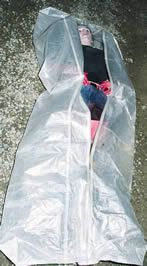Death.
(This is not a real corpse)
According to Webster's, death is a permanent cessation of all vital functions, the end of life, the state of being dead, the destroyer of life represented usually as a skeleton with a scythe (when capitalized).
Our body's cells die when they stop receiving oxygen. This happens one of two ways - our hearts stop beating and circulating oxygen through our blood stream, or we stop breathing and bringing new oxygen into our lungs.
The first cells to go are the ones that need the most oxygen: the ganglionic cells of the central nervous system (including the retinal ganglion cells, the cells in the eye that transmit visual information to the brain. Perhaps this is why we "see the light" in our final moments?). Once the cells of the brain stem die, any respiratory or circulatory function that remains will cease.
Once our cells are dead, they no longer produce the energy that warms our bodies, so our temperature drops (algor mortis). Our blood, no longer propelled by our hearts, succumbs to the force of gravity and pools in the areas closest to the ground (livor mortis). Our muscle tissue, without oxygen, stiffens (rigor mortis). Every now and then, biochemical reactions can cause our dead arms and legs to twitch. And, according to the BBC, "On the odd occasion, when these gases reverberate against the vocal cords, noises may even be produced."
AHHHH!
Then the real fun begins: decomposition.
Once our white blood cells are dead, they can no longer combat the bacteria that live in our bodies. So, these bacteria grow and begin to break down internal tissues. This biochemical process releases gases that bloat the body and produce that lovely rotten corpse smell. Eventually, the bacteria will break all of the tissue down until only a skeleton remains.
Unless, a lot of water is involved and the corpse becomes too acidic for bacteria to feed. If that happens, "the body fat remains as adipocere, a yellowish-white, greasy, waxy substance which smells of cheese, earth and ammonia. This substance floats on water, dissolves in hot alcohol and ether, and when burned produces a faint yellow flame."
Whoa!
The transformation of body fat into soap-like adipocere is called saponification, and it is especially common in corpses with a lot of fat (obsese corpses, infant corpses) or any and all corpses that have been laid to rest in air-tight caskets in moist ground.
"Many - and perhaps most- dead bodies interred within USA and Canadian cemeteries during the past century are still largely intact, 'down there' - and it's all due to adipocere formation. The grisly image of millions of buried and entombed soap mummies might not be serene, but it is apparently a shocking reality."
I won't force the evidence upon you, but if you're interested in knowing what these look like, click here.
I, personally, do not want to be a soap mummy. I want to be left out to rot on the open acres of the University of Northern Iowa's Body Farm in Tennessee.
Don't you?


1 comment:
whoa! its a very good explanation of Decomposition of body.
well done! ♥♥♥ its great
fr:
>>jecka Malonzo<<
Post a Comment